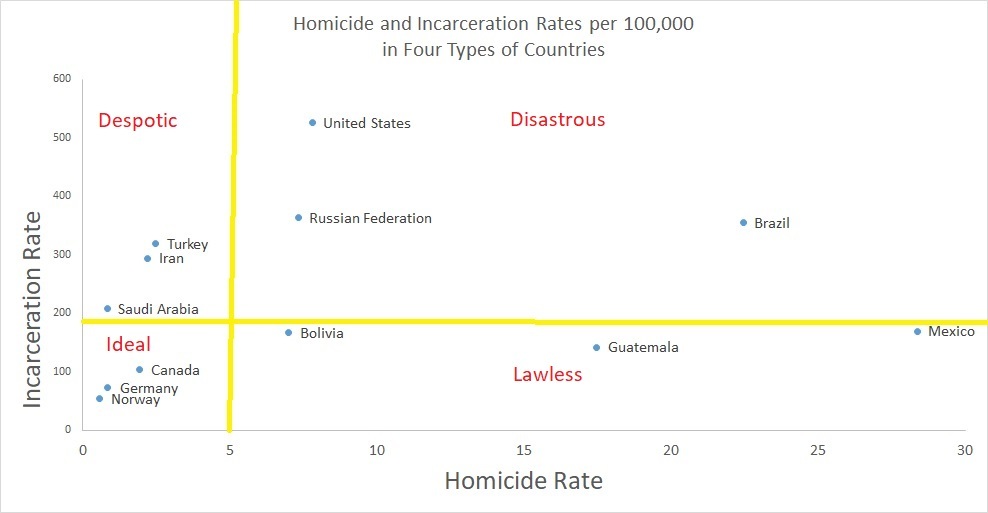America’s latest spate of mass shootings, including a number perpetrated by individuals with long criminal records, is fuel for a long-running debate. On one side are those pointing at the overall rise in homicides and decrying a lack of toughness in the criminal justice system. On the other side are those who see the criminal justice system as inherently unjust and want it cut back or even abolished.
Both camps are, in some ways, correct, and they are also, in some ways, wrong about America’s challenges regarding violent crime and incarceration. To appreciate this, it helps to consider both outcomes (violent crime and incarceration) simultaneously rather than try to interpret them without context.
The accompanying chart shows international data on the rate at which people are behind bars in different countries and the homicide rates in those countries. (This remains the most reliable global metric of violent crime.) Each quadrant includes many nations; the chart includes three illustrative examples of each.

In everyone’s eyes, the ideal place to be represented is in the lower left quadrant of low violence and low incarceration. Western European countries and our neighbor to the north, Canada, enjoy the public safety Americans lack without tolerating the costs and brutality of a massive prison system. But there’s a significant disagreement on how to get to this ideal.
Anti-incarceration activists tend to think of the United States as fitting in the upper left quadrant with other despotic regimes that lock a large number of people up without good reason—think of Iran throwing feminist protesters in prison. If you assume the U.S. doesn’t have much of a real crime program and incarceration is mainly for trivial crimes or entirely an expression of racism, the solution is obvious: Slashing incarceration would drop the U.S. down into the ideal quadrant with Western Europe.
Of course, some people are unjustly confined in the U.S. Still, almost 60 percent of those in state prisons are serving a sentence not for protesting or pot smoking but for a violent crime, and many of the other 40 percent have committed violent crimes unrelated to their current sentence. The U.S. murder rate, 8.1 per 100,000 in 2021, is vastly higher than that of its peer countries with low incarceration rates that populate the ideal quadrant. (In most European nations, the homicide rate is less than 1 per 100,000.) If Norway had the U.S. murder rate and maintained its current ratio of prisoners per murder, its incarceration rate would rise over 13-fold and exceed that of the US.
Rather than dropping the U.S. into the ideal quadrant, cutting incarceration without reducing violent crime would make the U.S. more like the lower right quadrant. These countries, including Mexico and Guatemala, have extensive violent crime that goes largely unpunished. People fearing violent crime flee from these countries to the U.S., not the other way around.
Anti-crime advocates talk as if they believe the U.S. is already in the lawless quadrant along with countries like Mexico and Guatemala. From that perspective, ramping up incarceration seems sensible.
But, in truth, the U.S. is in the embarrassing position of being in disastrous shape, joining places like Russia and Brazil in the quadrant with the worst of both worlds: high rates of homicide and high rates of incarceration. The challenge to the get-tough crowd is that if a high imprisonment rate would reduce violent crime, we’d already be a very safe nation.
At the risk of sounding like I’m to break out into the chorus of Kumbaya, there is a rational way forward for both sides to move America into the low-crime, low-incarceration quadrant populated by most other developed nations. This would require the tough-on-crime camp to give up on the idea that more incarceration will reduce violence and the anti-incarceration camp to stop minimizing violent crime in America. (“It was worse in the 1980s,” a familiar refrain, is of no comfort to today’s grieving families of murder victims.) Instead, both sides could rally around the range of health (e.g., expanding Medicaid), law enforcement (e.g., focused deterrence), and tax policies (e.g., raising the price of alcohol) that have good evidence of reducing violent crime, which in turn will reduce incarceration. This policy agenda will require a broad coalition. The first step towards that is for everyone in the debate to recognize that the people they’ve been yelling at have a good point, too.



